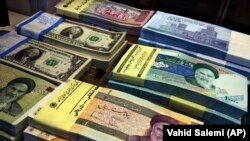The depreciation of Iran’s currency against the U.S. dollar has continued in recent days, reaching near all-time lows as the country faces multiple economic challenges.
Iran’s rial on Wednesday came close to 180,000 against one U.S. dollar, registering an 11 percent decline in the past two months. The rial has also lost value against the euro and other major currencies, as well as against gold.
Before the 1979 revolution in Iran each US dollar traded for 70 rials. Today's exchange rate shows around a 2,500-fold fall for the currency in 41 years.
In March 2017, the rial was trading at 37,000 against the U.S. dollar, but it began to lose value towards the end of that year as fears spread of a possible U.S. withdrawal from the Iran nuclear deal and the imposition of new sanctions.
The rial’s decline has continued since then, with occasional ups and downs. But now, after a year of full U.S. oil sanctions the country’s foreign currency reserves are dwindling and the government is forced to print more money, fueling an already high rate of inflation.
In recent weeks people flocked to Tehran’s stock market as a hedge against devaluation of their capital and the market rose 50 percent in two months. However, in the past several trading sessions stock prices seem to have tanked and the market is losing value.
The coronavirus pandemic has also hurt the already bleak economic outlook. The International Monetary Fund predicts Iran’s Gross Domestic Product to decline at least by six present this year, on top of a similar decline in 2019.





